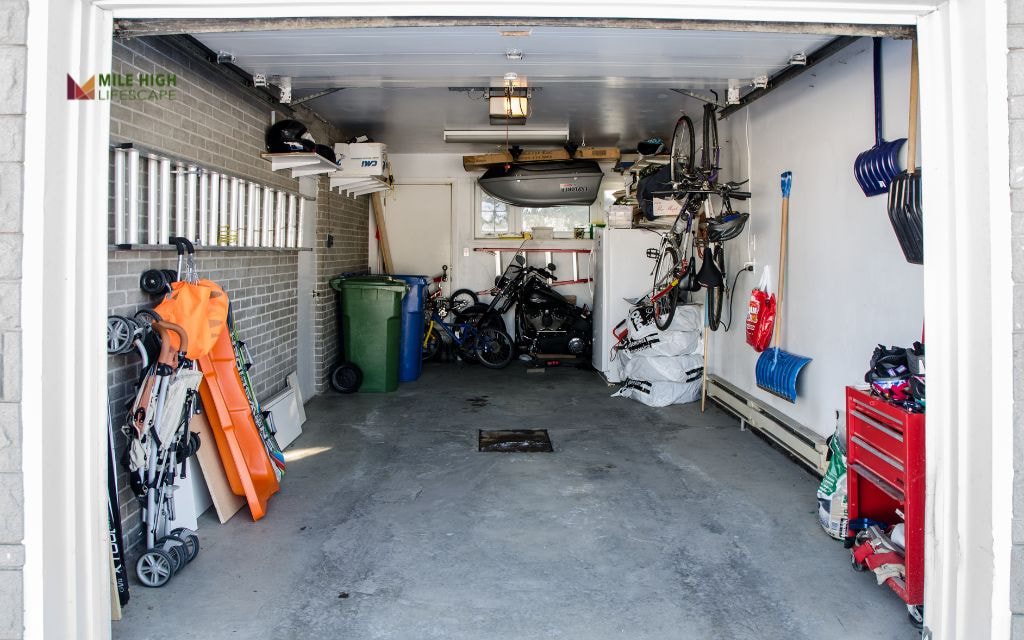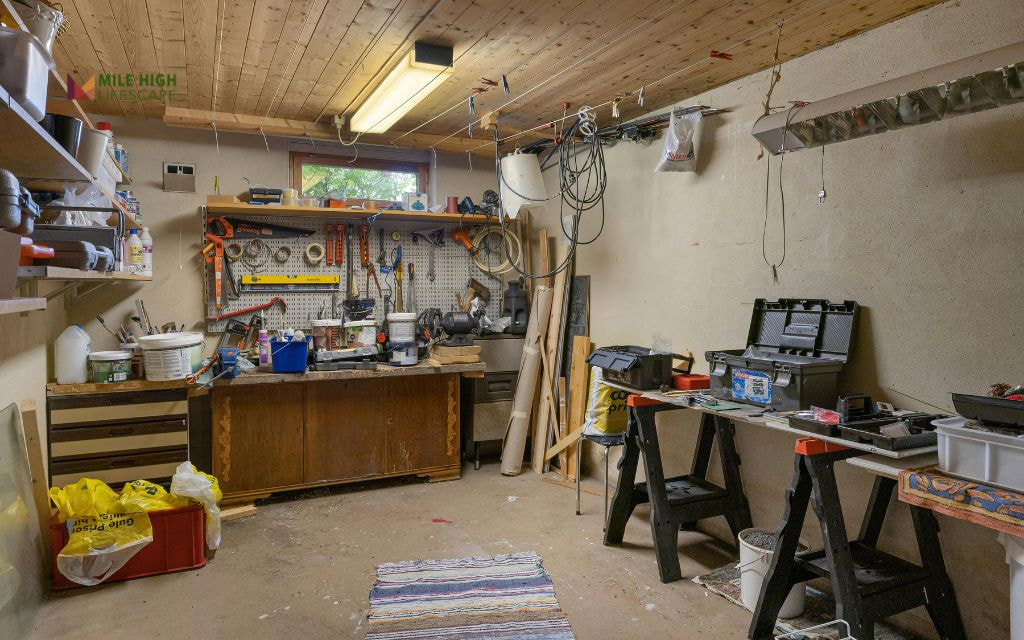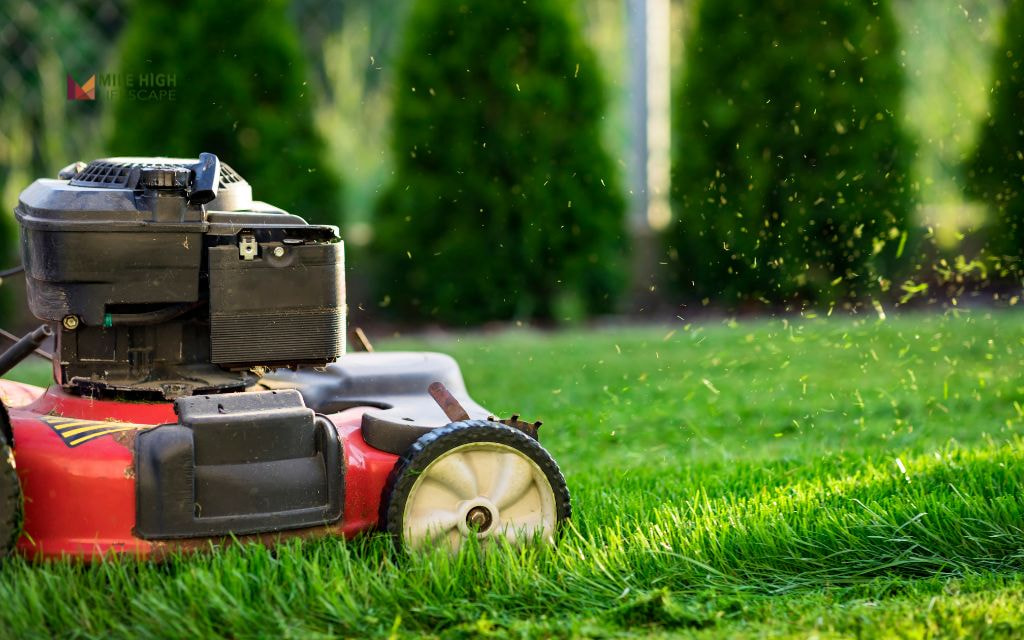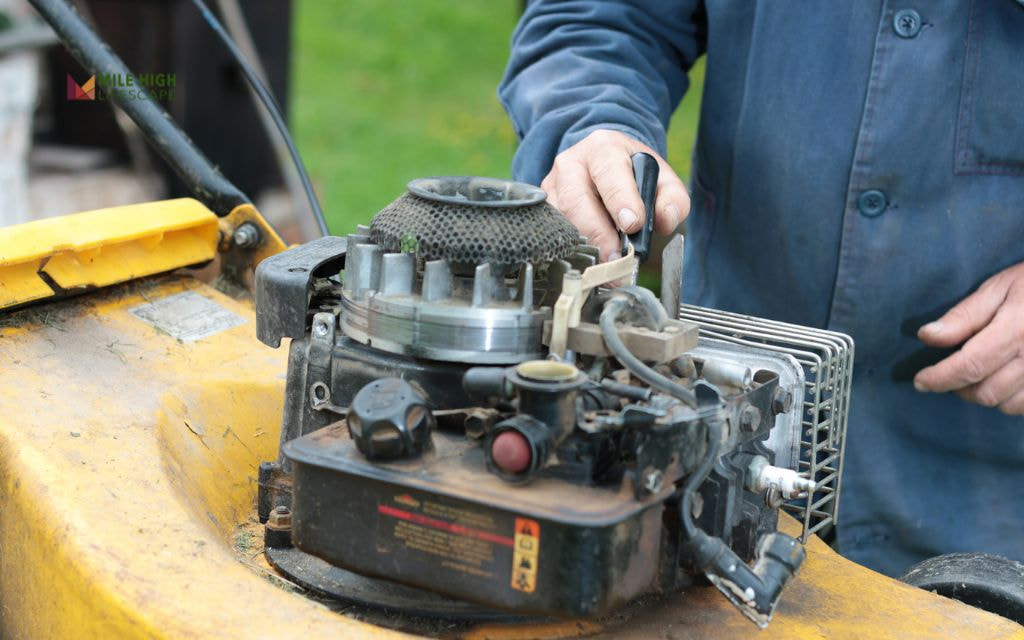Wondering how to store a lawn mower in the garage without sacrificing valuable space? Proper lawn mower storage protects your investment and maximizes garage functionality. At Mile High Lifescape, we’ve examined hundreds of garage storage configurations.
What separates effective storage solutions from inefficient ones? This guide shares professional strategies to store your mower effectively, safely, and efficiently for every garage size and equipment type.
Assessing Your Garage Space
Start by evaluating your garage layout. Measure dimensions and identify underutilized areas. Most garages offer three potential storage zones:
- Floor space – Requires planning to maintain walkways and vehicle access
- Wall space – Vertical storage options free up floor area
- Overhead space – Often overlooked but valuable for seasonal equipment
In Denver garages, where snow blowers and other seasonal equipment compete for space, efficient organization becomes essential. Consider traffic patterns, access needs, and safety requirements.
Ensure any storage solution maintains:
- Clear pathways to exits
- Adequate ventilation, particularly for gas-powered equipment
- Appropriate distance from heat sources and electrical panels

Preparing Your Lawn Mower for Storage
Before placing your mower in storage, proper preparation prevents damage:
Thorough Cleaning
Remove all grass clippings, dirt, and debris from the deck, blade, and wheels. Use a wire brush for stubborn buildup and wipe down with a clean cloth. This prevents moisture from causing rust during storage.
Fuel Management
For storage less than 30 days: Add fuel stabilizer according to manufacturer instructions.
For longer storage: Run the engine until the fuel system empties completely. Denver’s dry climate reduces moisture concerns, but fuel stabilization remains essential for equipment preservation.
Oil Service
Change the oil before extended storage to prevent contaminants from damaging internal engine components.
Battery Maintenance
For electric mowers: Remove the battery and store it in a climate-controlled environment.
For gas mowers with electric starters: Disconnect the battery and store it separately or use a trickle charger.
Blade Care
Remove and sharpen the blade or at least ensure it’s clean. Apply a light coat of oil to prevent rust.
How To Store A Lawn Mower In The Garage: 15 Effective Solutions
Designated Parking Spot
Create a specific floor area for your mower. Install a heavy-duty garage mat beneath to catch oil or fuel drips and protect your concrete. This simple approach works well for large garages where floor space isn’t at a premium.
Wall-Mounted Hooks or Brackets
Install sturdy wall brackets designed specifically for lawn equipment. This method works best for push mowers and electric models weighing under 70 pounds. Verify your wall construction can support the weight and use appropriate mounting hardware.
Overhead Storage Rack
Ceiling-mounted storage systems utilize unused space above. These adjustable racks work well for seasonal storage of push mowers.
Ensure proper installation into ceiling joists and remember that this solution requires lifting the mower overhead – not ideal for heavier models or frequent access.

Workbench Integration
Position your mower beneath a folding workbench. This dual-purpose solution maximizes space efficiency while protecting your equipment. Many Denver homeowners find this arrangement ideal for winter storage.
Rolling Cart or Dolly
Place your mower on a dedicated rolling platform. This mobility solution allows easy repositioning when cleaning or accessing other items. The added bonus: moving the mower becomes effortless regardless of its weight.
Cabinet or Enclosed Storage
Install a large cabinet specifically for lawn equipment. This protects from dust and provides clean visual organization. Select cabinets with ventilation if storing gas-powered equipment.
Pegboard Organization System
Install pegboard panels above your mower’s floor storage spot. This creates accessible storage for accessories like fuel cans, oil containers, and spare parts. The visual organization improves garage efficiency.
Under-Shelf Storage
Mount heavy-duty shelving at appropriate height to park your mower underneath. This method combines vertical storage with floor utilization. Ensure adequate clearance and shelf strength for any items stored above.
Corner Storage Stand
Utilize corner racks designed specifically for lawn equipment. These space-efficient solutions transform unused corners into functional storage. Many models include additional hooks for trimmers and edgers.
Outdoor Storage Box
For garages with severe space limitations, consider a weatherproof storage box positioned just outside. Select models rated for Denver’s climate extremes with proper ventilation for gas equipment.
Climate-Controlled Solutions
Create an insulated storage section to protect equipment from temperature fluctuations. This becomes particularly important in Denver where winter temperatures often drop well below freezing. Simple insulation panels create an adequate buffer zone.
Small Garage Adaptations
Implement vertical storage systems with multiple levels to maximize limited space. Foldable or collapsible storage units provide flexibility in tight quarters. Wall-mounted organizers keep accessories off the floor.
Large Garage Organization
Designate equipment zones to separate lawn care, snow removal, and other seasonal tools. Create a comprehensive storage system with labeled areas for each category. Larger spaces permit more permanent installations with dedicated function areas.
Budget-Friendly DIY Solutions
Build custom storage using reclaimed wood, PVC pipe, or repurposed materials. Simple DIY projects like pallet shelving provide effective storage without significant investment. Basic materials create functional solutions when professional installations exceed budget limitations.

Integrated Tool Storage
Establish a complete lawn care section incorporating mower storage with trimmer hooks, edger mounts, and supply shelves. This comprehensive approach organizes all related equipment in one accessible location. The efficiency gains from integrated storage prove substantial for active lawn maintenance seasons.
Addressing Denver-Specific Storage Challenges
Denver’s climate presents unique considerations for garage storage:
Temperature Fluctuations
Our region experiences substantial temperature swings throughout the year. During summer, garage temperatures can exceed 100°F, while winter brings frequent sub-freezing conditions. These extremes affect fuel stability, rubber components, and battery life.
Create temperature buffers through:
- Insulated storage cabinets
- Garage heating solutions for extreme cold
- Ventilation systems for summer heat
- Equipment covers that provide thermal protection
Seasonal Equipment Rotation
Denver homeowners typically manage both lawn equipment and snow removal tools. This seasonal rotation requires flexible storage systems.
Consider implementing:
- Modular storage components that adapt to changing needs
- Clearly marked seasonal zones
- Transition schedules for equipment preparation
- Multi-purpose storage solutions that accommodate different tool types
Humidity Management
While Denver’s climate tends toward dryness, humidity fluctuations still occur, particularly during spring and summer. Metal components require protection from condensation during temperature changes.
Effective humidity control includes:
- Desiccant packages placed near stored equipment
- Proper ventilation during humid periods
- Regular equipment inspection for moisture issues
- Application of protective coatings on metal surfaces
Why Proper Lawn Mower Storage Matters
Improper lawn mower storage leads to maintenance problems, reduced equipment lifespan, and potential safety hazards. In Denver’s climate, where temperatures fluctuate throughout the year, protection from extreme conditions becomes crucial.
Inadequate storage creates risks:
- Fuel system damage from stagnant gasoline
- Rust and corrosion on metal parts
- Battery degradation
- Increased fire hazards from fuel leaks
- Excessive garage clutter that impedes access
Implementing strategic storage solutions extends your mower’s life while maintaining garage functionality. Before selecting a storage method, assess your available space and prepare your mower properly.

Safety and Maintenance Considerations
Proper storage extends beyond organization to include critical safety practices:
Ventilation Requirements
Gas-powered mowers continue to emit fumes even when not running. Ensure adequate airflow through:
- Garage ventilation systems
- Periodic air exchange
- Storage away from living spaces
- Fuel cap inspection to prevent vapor escape
Child and Pet Safety
Implement barriers or locks to prevent unauthorized access. Store detachable components like keys and battery packs separately. Position equipment away from play areas and pet zones.
Fire Hazard Prevention
Mitigate risks through:
- Fuel stabilization or complete drainage for long-term storage
- Storage away from ignition sources and electrical outlets
- Inspection for fuel or oil leaks
- Proper cleaning to remove flammable debris
Regular Maintenance During Storage
Even while stored, equipment benefits from periodic attention:
- Monthly visual inspection
- Occasional repositioning to prevent tire flat spots
- Battery charge maintenance
- Seasonal startup preparation
Frequently Asked Questions (FAQs)
Is it safe to store a lawn mower in the garage?
Yes, it’s safe to store a lawn mower in your garage if you take proper precautions. Ensure good ventilation, stabilize or drain fuel for long-term storage, and keep the mower away from heat sources and electrical equipment.
How do you store lawnmowers when not in use?
Clean thoroughly, manage fuel, disconnect the battery, and place in a dry location using wall mounts, racks, or designated floor space.
Is it better to store a lawn mower with or without gas?
For short-term storage (less than 30 days), add fuel stabilizer to a full tank. For long-term storage, it’s better to run the engine until the fuel system is empty. Never store with a partially filled tank as this promotes condensation and fuel degradation.
Where can I put my lawn mower if I don’t have a shed?
Without a shed, your garage is ideal. Alternative options include:
- Under a covered patio with a weatherproof tarp
- In a weatherproof outdoor storage box
- In a basement (electric mowers only)
- Against an exterior wall with a custom-fitted cover
- In a utility room if space permits
Should I drain the fuel before winter storage in Denver?
For winter storage in Denver, either drain the fuel system completely or add fuel stabilizer to a full tank. Never leave partially filled tanks, as condensation in our fluctuating climate creates water contamination issues.
Can I hang my lawn mower on the garage wall?
Wall-mounting works for push mowers under 70 pounds with proper mounting hardware secured to studs. Riding mowers require floor storage due to their weight and dimensions.
How often should I check stored lawn equipment?
Inspect stored equipment monthly during off-seasons. This schedule allows early identification of potential issues like leaks, pest infestations, or storage system failures.
Conclusion
Effective lawn mower storage combines space optimization, equipment protection, and safety considerations. The solutions presented accommodate various garage sizes, equipment types, and Denver’s specific climate challenges.
At Mile High Lifescape, we recommend selecting storage methods that balance convenience with protection. Consider your usage patterns – equipment requiring frequent access needs different solutions than seasonal storage.
For personalized guidance on lawn equipment storage or professional lawn maintenance services that eliminate storage concerns entirely, contact Mile High Lifescape at (303) 877-9091. Our experts provide tailored solutions for Denver homeowners seeking to maintain both their equipment and garage functionality.
